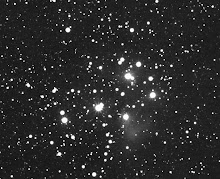Around 650 million years, three entire orbits of the solar system around the Milky Way Galaxy, passed as natural evolution distinguished between (I) Momentum, and (II) Energy. Octopuses, squids and certain shellfish which emerged during pre-Cambrian times, have used momentum for propulsion ever since.
That vast passage of time was not because of care or patience. It was because evolution was practically brainless, and thoroughly mindless. Any design that existed was on the spot planning by individual organisms for immediate goals. Care and patience can exploit evolutionary time rates, of course. Now, writing permits very long range goals to be undertaken.
Evolution was not entirely brainless during all this time. It was, though, only after warm-blooded mammals appeared that the solutions began rolling in rapidly.
It may be presumed that energy was first competently distinguished by human beings as they began to lift objects to make tools and shelter, use fire to keep themselves warm and through all of these reduce energy expenditures and requirements necessary to survive. This was probably what allowed human beings to abandon fur.
Eventually with the construction of stone block pyramids, the energy anticipated in reaching the Moon was first approximated. It turns out that in the 3 million blocks in the Great Pyramid of Giza, the total gravitational energy is surprisingly close to the energy necessary to reach the Moon. The advantage of making the demonstration permanent was that the energy stored in those blocks is durably displayed and it was within those structures that now-famous paintings depicting bird-headed men in winged boats sailing over waters to the disks in the sky were preserved.
The pyramids are energy. They were the first enduring models of the energy that would be involved in flying to the Moon. That they still exist is one of the wondrous parts of the story of space flight. Momentum and energy are closely related concepts in physics. In fact, E = (p^2)/(2*m) where E is energy, p is momentum, and m is mass. Conversely, p = SQRT(2 * m * E). The proportionality involves squares and square roots - testament to the efficient information structures which the pyramids were designed to be. Heavy, but simple and direct.
Whether we do better or not is not in question. Modern technology is of course far more sophisticated. The important point is that the Egyptians created something that has physical meaning in the context of flight to the Moon. What is necessary is that we recognize the patient and slow time scale of conscious human activity toward goals it chooses. Human beings were not being patient or wise because they spent 35,000 years or so going from fire to pyramids. To put it most simply, knowledge did not exist, and when it was obtained it was quickly lost because writing had not been invented.
At the present time, human beings have become determined to put Earth, the house of Man, into better order, by taking care of its own population, the Earth itself and of the other inhabitants and living things of the world. Certain aspects are in critical disarray. Human population is so great it is consuming almost all other large animals as food.
The world still preserves an ancient goal of flying to the stars. But that is not viewed with the urgency of the first Moon flight. Orbital flight around the world now makes it possible for people to venture into space far enough to see the Earth in proper scale and proportion. Almost universally, they have returned visions of grandeur and awe, amazement and wonder, and concepts of the Earth as having literally infinite value to all that is known about life anywhere. The concept of Earth as home is inescapable, and it brings all the responsibilities and tender protective regard for the planet that are always equated with home.
This alone is one of the most important reasons to sanction, though carefully, private-industry development of orbital space flight, including permanently inhabited space stations. The aggressive concept of creating a privileged
class of space-flying people is loud but not as important as the fact that
the more people who do orbit the Earth, the more certainly will good decisions
emerge about how to care for it. This is a long term goal with very important consequences. Careful planning in the beginning will be well worth the time.
Space flight to the stars, though, could wait a thousand years and still be called rapid development in the evolutionary time scale. Preliminary research is already under way, yet flight to the stars is an immense project. Advances are being made in the principles and concepts of lift without any kind of wings, jets or rockets. Given rates as history indicates them, flight to the stars could take anywhere from a thousand to a hundred thousand years. It is not likely to happen sooner; this new millennium will be dominated by exploration of the Solar System.
Demonstration devices, presenting levitation with no moving parts no fluctuating electric or magnetic fields, and no expenditure of power, can be purchased from the popular science supply corporation Edmund Scientific. They are not costly - about forty dollars each. Both levitate suitable objects on magnetic fields. One uses cryogenically superconducting material, so energy is required to supply the liquid nitrogen for refrigeration. The other uses room temperature magnets and a phenomenon called pyrolytic diamagnetism to float a carbon object on a magnetic field. Both cause many who first see them to imagine flying saucers.
Tiny models of astronauts and space ships can be supported on the levitating
samples, particularly if a model helps inspire dreams. And as always, as with electricity, someday a tax may be placed on such things.
Subscribe to:
Post Comments (Atom)








No comments:
Post a Comment